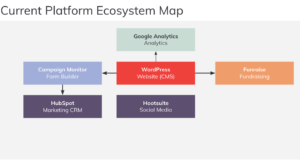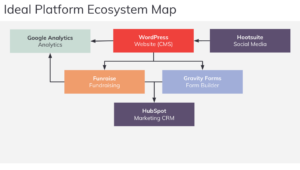
How to Build Your Nonprofit’s MarTech Stack
This blog is the third in our series on MarTech for nonprofits. If you want a refresher on what MarTech is, check out the first blog here. If you want to know why every nonprofit organization should have a MarTech stack, read the second blog here.
MarTech Stacks, or Marketing Technology stacks, provide nonprofit teams with a vital way to create efficient and effective marketing efforts. But, how does an organization begin to piece one together?
The good news is that you likely already use at least one marketing tool, meaning you are well on your way to building a MarTech stack. Explore the steps below to learn how to build a MarTech stack and how your team can use those tools.
Ask Questions About the Tools You Already Use
When Media Cause helps a nonprofit audit their MarTech tools, the first thing to do is ask questions that are designed to start a fuller conversation about the technology used to make the work more manageable. As your nonprofit team begins that conversation, be sure to write down the answers. A few questions to consider include:
- How do we organize information about our donors, volunteers, members, and constituents? Where is that information stored? Is the information in a platform, database, or, worse, a spreadsheet?
- Do we have one place that serves as our ‘source of truth’ for our constituent’s information? Are we confident that the information in this system is up-to-date and relevant to our organization?
- Are we currently using an online platform to send emails to our constituents?
- Where do we go to log in and make updates to our website?
- Are we using any forms on our website and landing pages to collect information from users who are interested in our organization?
- Do we have an online platform to collect donations? Are we doing anything to follow up with those donors?
- Where do we go to learn about our website’s performance?
While this list is great for starting the discussion, for a more detailed audit and analysis, enlist the support of Media Cause MarTech experts.
Dig Deeper to Discover What’s Missing
Running through this additional exercise may help you make the business case that a new or updated platform is necessary for the organization’s efficiency when mapping your ideal MarTech stack below.
- Once you have surveyed your organization and learned about the tools in use, have you come up with any pain points?
- Are there any tools that are glaringly missing or that aren’t serving the team well?
- Is information from your donation platform making it over to your CRM?
- When a user on our website completes a form indicating they want to hear from your organization, is that being passed to your email marketing platform?
Map Your Current MarTech Stack
After your nonprofit has taken stock of the tools you are already using and insights gathered from discussions, you can begin one of the most revealing steps in the process—mapping out how your current tools do or do not work together in a diagram, called a MarTech Ecosystem.
In the diagram below, a rectangle represents each platform and includes the type of platform it is and its name. Then, arrows show how information moves from one platform to another, and a lack of arrows means there is no information moving between the platforms.
In the example above, the organization recently adopted HubSpot to fill the role of email marketing and CRM but still needed to integrate it fully into its processes. Information from their fundraising efforts and traffic to their site is not sent to the CRM, leaving critical information behind. This leaves the organization lacking a place that houses all of their data, acting as their “one source of truth” that they can plan from and use to check all other sources of information.

Define Your Ideal MarTech Stack
Using the diagram you made of your current MarTech stack, create a version of it that is updated to reflect your nonprofit’s ideal state. Your information should flow between platforms in a way that creates efficiency and a source of truth.
In this ideal diagram of a MarTech Ecosystem, HubSpot serves as the organization’s source of truth—a place where they will keep information about constituents, send marketing emails, run retargeting campaigns, and more. Information from their donation platform, Funraise, and their form builder, Gravity Forms, flows into the CRM through integrations in HubSpot. The diagram also shows that their social media channels drive users to their website, and the website’s goal is to drive conversions through donations or by completing a form. In this way, the MarTech stack also helps shape part of the user’s journey.
Choose the Right Tools + Integrations for Your Team
Ultimately, building an effective MarTech stack is vital for any nonprofit organization looking to streamline its marketing efforts and enhance engagement with its audience. You can create a more cohesive and efficient MarTech Ecosystem by thoroughly evaluating your current tools, mapping out how they interact, and identifying gaps or inefficiencies, ensuring that critical information flows seamlessly across different platforms and aligns your marketing strategies more closely with organizational goals.
An optimized MarTech stack is not just about having the right tools—it’s about integrating those tools effectively to support your mission, enhance community and donor engagement, and ultimately, drive success for your organization. Our team is highly experienced in facilitating discussions, identifying challenges and opportunities within Ecosystems, and guiding nonprofit teams through the decision-making, set-up, and maintenance processes to build a customized MarTech stack designed to help you achieve your goals.
